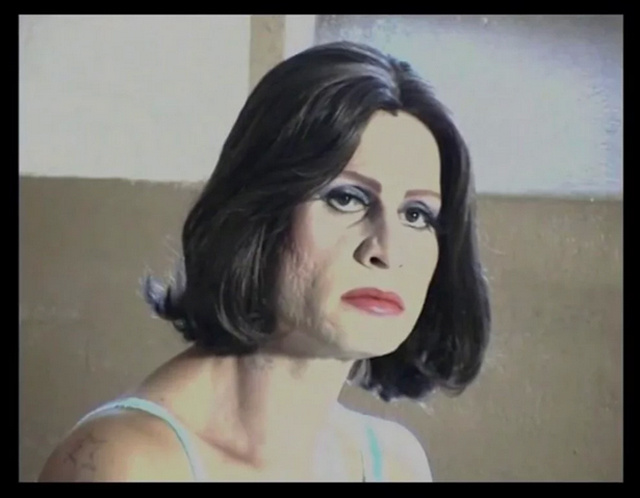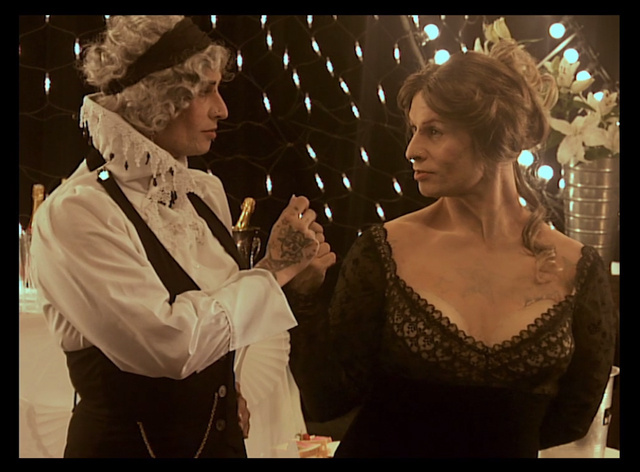
Advertisement
Brice Dellsperger: I started the series when I was a student at Villa Arson in Nice. At that time, I completed three short scenes taken from De Palma—I didn't know then that those works would act as the impetus for my entire body of work. The funny thing is it all started as a reaction to the failure of my initial idea for working with the material. The first concept was to create a series of live performative interventions in public spaces: the Dressed to Kill murder scene in the lift starring Angie Dickinson and Michael Caine in drag, the chase scene in the shopping mall in Body Double with Deborah Shelton and Craig Wasson… I shot the chase scene (it’s an early work entitled Eye Bags that was shot in Nice Etoile, the shopping mall in downtown Nice), but all my friends freaked me out, saying that it was unthinkable to do the slasher scene in the lift. Can you imagine me rushing on a stranger dressed up as a transvestite with the movie soundtrack playing in the background on a ghetto blaster and a team filming it? I decided to play both characters for that scene, and then the concept of doubling people into iconic feature films started.
Advertisement
As I said, the project was originally composed of only three short videos featuring only myself, but I kept finding excerpts that I wanted to double. The evolution has been possible because first I decided to use other people, like professional transvestites, to perform; then I used special effects, always very low-tech and easy ones like split screens and dissolves; then keying became accessible with the first Final Cut Pro software. The technical aspect was and is always a condition of the work. Also another evolution was to double a full-length feature film—I asked Jean-Luc Verna to act as the stand-in for a classical muse, which entailed us making multiple works together, often featuring him as the only actor. I became interested in the aesthetic and conceptual consequences of using the same performer in different Body Doubles, to reshoot the same scene several times but with all different actors… So many combinations and variations appeared as the work became more serious and I got more invested in it, and as I grew a specific taste for cinema and gained technical skills in special effects.Body Double 5, Brice Dellsperger's reprise of Brian de Palma's Dressed To Kill in Disneyland (1996). Courtesy of Air de Paris and Team Gallery, New YorkYou have appropriated films from David Lynch, Stanley Kubrick, Alfred Hitchcock, Brian De Palma, and many more. How do you choose which films to “double”?
I started as a novice, but what I particularly appreciated about film was its vulnerability to appropriation. I did not formally study cinema—I just discovered movies—but I guess I have always had a compulsion to watch a specific scene over and over when I really like it. How do I choose the scenes? The question is always coming back. I have no specific method, sometimes one scene that I saw many years before just pops out as the one that I want to reexamine a few years later. I would say it’s all a matter of the right scene at the right moment, so there is no rule for that; it’s like an encounter. But of course, some movies are easier to transform than others.
Advertisement

Cinema is one of the most important things in my life, though I don’t go to movies that often. It’s a weird relationship to cinema, I would say. I am totally into it, but a TV addict at the same time. I find it sometimes so ridiculous and useless, but it is a passionate love story; would that sound too dramatic?One of my favorite parts of the Body Double works are the small glitches and technological imperfections that come with only using one or two actors. It seems to immediately reveal the artificiality of filmmaking and throw authenticity into question. What interests you about these imperfections in the video process?
The authenticity is a very good question! The "realness," as the performers in Jennie Livingston’s Paris Is Burning would say. Of course it’s a central aspect of my work, like the fact that I want to explore and push the boundaries in something that has already been decided as the one and only version, the official, the serious, and the true. By using special effects where normally a director would not use them, and by showing this process, even making the artificiality more obvious, some tiny parts of reality reappear in those little gaps that are now created. I like to say that I am reversing the identification process of one’s view of a ready-made scene.
Advertisement
Drag is the starting point of it, actually. When I was a student, with Jean-Luc and other friends, we were going to a club in Nice where impersonators were performing almost every night. I was fascinated! I think my work has a lot to do with these gay nightclub cabarets. They are, in a way, real-life video projections. The mise en scène and effects are all in there. The way the transformists are dressed up, made-up, moving, lip-synching, with a specific economy of gestures, sometimes cheap—it’s already like a Body Double. My interpretations of these good moments are just a transfer to the cinema industry. There should be more drag in the film industry.

My taste for camp cinema is obvious; I love John Waters, whose work was one of the most important discoveries I made while in Nice. At that time, it was really difficult to find videotapes of Pink Flamingos. Thanks to my very good friends Florence Bonnefous and Bruno Pelassy, I had the chance to see the entire works of Mr. Waters, and I fell in love with Divine. Who wouldn't? I think camp can be everywhere anyway.Body Double 17, Brice Dellsperger's reprise of David Lynch's Twin Peaks: Fire Walk with Me (2001), starring Gwen Roch and Morgane Rousseau. Courtesy of Air de Paris and Team Gallery, New YorkWith the glitches, the use of drag, and the copy in the videos, I can’t help thinking of the series in relation to Warhol’s films. Who are your artistic influences?
Warhol is a major influence. Waters, Fassbinder, De Palma, Pasolini, Argento, Anger, Russell. Paul McCarthy, Michel Journiac, Cindy Sherman, and others. I love also very kitsch and bad cinema, like Xanadu (guess why?). Thanks to Nick Mauss, I recently discovered Der Tod der Maria Malibran by Werner Schroeter, which is intensely beautiful! I try to keep a fresh eye about the movies.How would you like to affect the viewers of the Body Double series?
I have no idea of the way the people see the Body Doubles and why they love or hate them, to be honest. My vision and concept of the work is quite far removed from the videos that are ultimately presented in the gallery space. Sometimes when I watch a video a few years after it’s completion, I feel a bit amazed. For example Jean-Luc's performance in Body Double 22 is, I think, a masterpiece. Seeing Jean-Luc in every role in the feature film Body Double (x) after Zulawski's L'important c'est d'aimer is still a total trauma, and not only because it took two years and a lot of sweat to achieve it. The Body Doubles have different effects on people, like the layers they contain. They could be seen as a farce, and sometimes so serious that I hope one can feel touched by it and get emotional. Like in real movies, I would say!Emily Colucci is a New York–based writer and the co-founder of Filthy Dreams, a blog that analyzes culture through a queer lens. Follow her on Twitter.